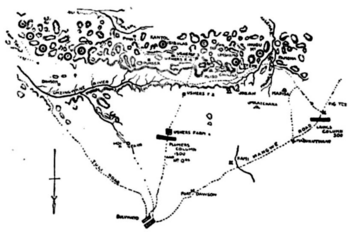Second Matabele War facts for kids
Quick facts for kids Second Matabele War |
|||||||
|---|---|---|---|---|---|---|---|
| Part of the Matabele Wars | |||||||
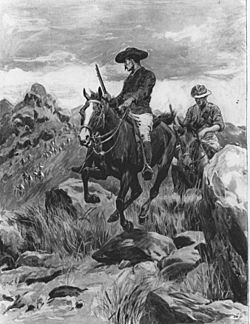 Depiction of Burnham and Armstrong after the assassination of Mlimo. Matabele warriors in hot pursuit, drawn by Frank Dadd. |
|||||||
|
|||||||
| Belligerents | |||||||
| Matabele Shona |
|||||||
| Commanders and leaders | |||||||
| Robert Baden-Powell Frederick Carrington Cecil Rhodes Herbert Plumer |
Mlimo † Sikhombo Mguni Inyanda |
||||||
| Casualties and losses | |||||||
| ~400 | ~50,000 | ||||||
The Second Matabele War, also known as the Matabeleland Rebellion, was a major conflict fought between 1896 and 1897. It took place in the region now known as Zimbabwe. This war involved the British South Africa Company fighting against the Matabele and later the Shona people. In Zimbabwe, this conflict is also known as part of the First Chimurenga, which means "uprising" or "struggle for freedom."
In March 1896, the Matabele people rose up against the British South Africa Company. Their spiritual leader, the Mlimo, played a big role in starting the rebellion. He convinced the Matabele and Shona that the European settlers were causing all their problems. These problems included a terrible drought, swarms of locusts, and a cattle disease called rinderpest.
The Mlimo chose a good time for the uprising. Just a few months earlier, most of the British South Africa Company's soldiers had left. They went to fight in the Jameson Raid in the Transvaal Republic, which failed. This left the area almost unprotected. The British quickly sent more troops to stop the Matabele and Shona. Many lives were lost on both sides. The war continued for many months, until October of the following year.
Contents
The War in Matabeleland
The Rebellion Begins
The Mlimo had a plan to surprise the town of Bulawayo on the night of March 29. He told his followers that if they fought, the settlers' bullets would turn to water. He also said their cannon shells would become harmless eggs. The plan was to kill all settlers in Bulawayo but leave the town itself standing. It would become the new royal home for King Lobengula. The Mlimo wanted the settlers to be driven out through the Mangwe Pass, which was left open for this reason. After Bulawayo, the warriors would spread out and continue fighting until all settlers were gone.
However, some young Matabele warriors were too eager to wait. The rebellion started earlier than planned. On March 20, rebels attacked and killed a local policeman. Over the next few days, other settlers and gold prospectors in the countryside were also killed. Frederick Selous, a famous hunter, heard rumors but thought it was a small issue. When he learned about the policeman's murder on March 23, he realized a huge uprising had begun.
On March 24, nearly 2,000 Matabele warriors officially started the rebellion. Many local police officers joined the rebels. The Matabele fought with various weapons, including rifles, spears (assegais), and battle-axes. As news spread, the Shona also joined the fight. Settlers rushed to Bulawayo for safety. Within a week, 141 settlers were killed in Matabeleland and 103 in Mashonaland. Hundreds of homes and mines were burned.
Siege of Bulawayo
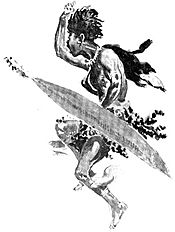
With few soldiers, the settlers in Bulawayo quickly built their own defenses. They used wagons filled with sandbags in the town center. Barbed wire was added, and oil-soaked bundles of sticks were placed to light up the area at night. Explosives were hidden in buildings outside the main defense line. Broken glass bottles were spread around the wagons. The settlers had mostly hunting rifles, but also a few cannons and machine guns.
Instead of waiting, the settlers formed patrols called the Bulawayo Field Force. Leaders like Selous and Frederick Russell Burnham led these groups. They rode out to rescue survivors and attack the Matabele. Selous led 40 mounted men to scout the Matobo Hills. Maurice Gifford and 40 men rode east. Any settlers found were quickly brought back to Bulawayo. In the first week, 20 men from the Bulawayo Field Force were killed and 50 wounded.
The Matabele had seen how effective the settlers' Maxim guns were in the First Matabele War. Because of this, they never launched a full attack on Bulawayo, even though over 10,000 Matabele warriors were nearby. Life inside Bulawayo became very difficult. During the day, people could use buildings, but at night they had to crowd into the smaller wagon fort. Nearly 1,000 women and children were crammed together, and false alarms of attacks were common. The Matabele made one big mistake: they did not cut the telegraph lines to Mafeking. This allowed Bulawayo to get important information.
Several groups of soldiers were sent to help Bulawayo, but the journey through enemy territory took months. In late May, the first two relief columns arrived almost at the same time. Cecil Rhodes and Colonel Beal came from Salisbury and Fort Victoria (300 miles north). Lord Grey and Colonel Plumer came from Kimberley and Mafeking (600 miles south). The southern forces were almost ambushed, but Selous found the Matabele. Their Maxim guns drove the attackers back. Soon after, General Frederick Carrington arrived to take overall command, with Colonel Baden-Powell as his chief of staff.
With the siege broken, about 50,000 Matabele retreated into the strongholds of the Matobo Hills. This area became the site of the fiercest fighting. By June, the Shona joined the Matabele in the fight. However, without a strong leader like Mlimo, the Shona mostly stayed behind their defenses and launched few attacks.
The Mlimo's Death
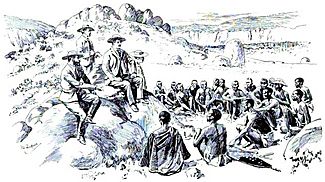
Military leaders believed that capturing the Mlimo would end the war quickly. An informant told Bonar Armstrong, a local official, where the Mlimo's sacred cave was. Armstrong shared this with Frederick Russell Burnham, the Chief of Scouts. They told Earl Grey, who was in charge of Southern Rhodesia. Earl Grey then told General Carrington, who ordered Burnham, Armstrong, and Baden-Powell to go that night. Their mission was to "Capture the Mlimo if you can. Kill him if you must. Do not let him escape." Baden-Powell had to go elsewhere, so Burnham and Armstrong went alone to the Matopos.
Burnham and Armstrong traveled through the Matobo Hills at night. They found a village of about 100 huts near the sacred cave, filled with many warriors. The two scouts tied their horses and crawled on their bellies, hiding behind branches. Inside the cave, they waited for the Mlimo.
When the Mlimo began his ritual dance, Burnham shot and killed him. The two men then ran towards their horses. Hundreds of warriors nearby grabbed their weapons and chased them. Burnham set fire to the village to create a distraction. The two scouts hurried back to Bulawayo, with warriors still pursuing them.
After the Mlimo's death, many people overseas praised Burnham and Armstrong as heroes. However, some in Rhodesia doubted if the right person had been killed. British military leaders thought the Mlimo was a single, powerful leader. But historians now believe there were several spiritual leaders, not just one central Mlimo.
After the war, Cecil Rhodes walked unarmed into the Matabele stronghold. He convinced the Matabele warriors to stop fighting. With the war in Matabeleland mostly over, the Bulawayo Field Force was disbanded on July 4, 1896. Many of the regular soldiers then moved to Mashonaland.
War in Mashonaland
The war in Mashonaland began on June 17, 1896, with an attack by the Hwata dynasty on Alice Mine in Mazowe. Soon after, the spiritual leader Nehanda Nyakasikana captured and executed a local official named Pollard.
Other religious figures who led the rebellion included Kaguvi Gumboreshumba, active in the Goromonzi area, and Mukwati, a priest who inspired people across Mashonaland.
Traditional leaders also played a big part. Chief Mashayamombe led resistance in his area, south of Salisbury (now Harare). He was one of the first chiefs to rebel and the last to be defeated. Other important chiefs included Gwabayana, Makoni, Mapondera, Mangwende, and Seke.
The British South Africa Company brought in more soldiers from the Cape Colony. With the war in Matabeleland ending, General Carrington could focus his forces on Mashonaland. The Shona rebels retreated into granite hills called kopjes. Carrington used Maxim guns against each stronghold until the resistance ended. Nehanda Nyakasikana and Kaguvi Gumboreshumba were captured and executed in 1898. However, Mukwati was never caught and died in Mutoko.
Legacy
The rebellion did not change the British South Africa Company's policies much. For example, the "hut tax" (a tax on homes) stayed in place. The areas of Matabeleland and Mashonaland became known as South Zambesia. Both the Matabele and Shona people were now under the rule of Cecil Rhodes's administration. It wasn't until 1924 that the entire region officially became a British Crown Colony. Before that, it was managed by the British South Africa Company. However, the legacy of leaders like Kaguvi, Mapondera, and Nehanda inspired future generations to fight for freedom.
Birthplace of Scouting
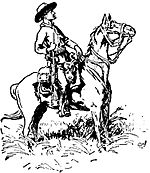
Soon after the war started, Baden-Powell became chief of staff to General Carrington in Matabeleland. Here, he met Frederick Russell Burnham, an American who was the Chief of Scouts for the British. This meeting led to a lifelong friendship and was very important for Baden-Powell. He loved leading scouting missions into enemy territory. Many of his later ideas for the Boy Scouts came from this time. Burnham had been a scout for most of his life in the United States. He came to Africa in 1893 to work for Cecil Rhodes on the Cape-Cairo railway. Burnham was known in Africa as he-who-sees-in-the-dark. He became famous in the First Matabele War for surviving the Shangani Patrol.
During their scouting trips in the Matobo Hills, Burnham taught Baden-Powell about woodcraft. This inspired Baden-Powell and gave him ideas for the Boy Scout program and its code of honor. Woodcraft skills, practiced by frontiersmen and Indigenous peoples of the Americas, were new to the British but well known to Burnham. These skills became the basis of what is now called scoutcraft, the core of Scouting. Both men realized that wars in Africa were changing. They discussed a training program for young men focused on exploration, tracking, fieldcraft, and self-reliance. It was also in the Matobo Hills that Baden-Powell started wearing his famous campaign hat, like Burnham's. He also got his Kudu horn there, which he later used to wake the first Boy Scouts at Brownsea Island.
1901 Mapondera Rebellion
In 1901, Chief Kadungure Mapondera led another rebellion in the Guruve and Mount Darwin areas of Mashonaland. He had declared his independence from company rule in 1894. He started with fewer than 100 men but had over 600 by mid-1901. He was captured in 1903 and died in jail in 1904 after a hunger strike.
Monuments
In his will, Cecil Rhodes asked to be buried in the Matopos Hills. When he died in 1902, his body was brought to Bulawayo by train. Ndebele chiefs attended his burial. They asked that the soldiers not fire their rifles, so as not to disturb the spirits. Then, they gave a European person the Matabele royal salute, "Bayete," for the first time. Rhodes is buried alongside 34 company soldiers killed in the Shangani Patrol. Leander Starr Jameson was also buried there after his death in 1917.
See also
- First Matabele War
- Pioneer Column
- British South Africa Company Medal
- Lobengula
- Nehanda Nyakasikana
- Kaguvi
- Kadungure Mapondera


